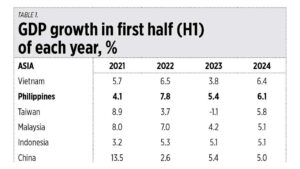
Coal, nuclear and economic growth
More countries have recently reported their second quarter (Q2) 2024 GDP performance. I can now update the performance for the first half (H1, Q1 and Q2) of the year and compare this with the same period over the last three years.
I found that the same trend is affirmed — Asia is experiencing medium to high growth except for Japan, while Europe is mostly slowing down, with GDP below 1% if not contracting like Austria, Germany, Ireland, Finland. In North America, Canada is following the European trend (see Table 1).
Many European countries are busy with priorities like saving the planet, saving net zero, saving Ukraine, saving illegal immigrants, saving DEI (diversity, equity and inclusion). But saving their economies from slowing growth seems a low priority for them. The Philippines and other Asian nations should not follow their economic and political path.
The anti-coal expansion stance of environmental activists — exemplified by their disapproval of Therma Visayas, Inc. (TVI) in Cebu — is grounded on climate alarmism and favoritism of intermittent renewables. Energy policy and planning by many governments around the world are influenced by the alarmism movement.
The data on Europe’s degrowth* are a result of decades of climate and energy policies. There was a fast exit from coal, and even from nuclear power, in Europe, and a quick embrace of wind-solar power, led by the UK and Germany. The average growth for many European countries from 2013 to 2023 has been anemic — Germany and France 1.1%, the UK and Spain 1.6%, Italy 0.7%.
In contrast, Poland and Turkey, which produced 100 terawatt hours (TWh) and 118 TWh respectively in 2023 through the burning of coal, have had higher GDP growth over the same period.
Coal use in Asian countries has been rising, led by China, India, Indonesia, and South Korea. Japan has also been using much coal, but this is because they temporarily pivoted away from nuclear energy after the big earthquake and damage to the cooling systems of the Fukushima nuclear plant. Asian countries, except Japan, have had an average growth of 2.5% to 6% over the same period (see Table 2).
Again, there are many factors for a country’s GDP growth, high or low, and the use of cheap, reliable fossil fuel energy is just one of them — but it is among the more important factors.
This week several friends forwarded to me the column of Dr. Vic Limlingan which came out here in BusinessWorld, “Our misguided energy policy” (Aug. 19) and asked me to comment on it.
Well, the beauty of his piece is that he does not endorse climate and energy alarmism and does not support the use of more wind-solar power, and instead pushed for the use of more coal and natural gas in the country’s energy mix until 2040. Bravo, Dr. Limlingan.
But what I did not agree with is that he lambasted the energy plan under energy secretary Raphael Lotilla without realizing that the secretary is pushing for the inclusion of nuclear energy in the Philippines energy mix.
From the recent draft paper — “Philippine Nuclear Energy Program (PNEP) 2024-2050: A Roadmap Towards Clean Energy” — released in mid-July, the Department of Energy sees nuclear and other sources contributing 19.4 TWh by 2040, and 38.6 TWh by 2050, or an energy share of 6.9% of the total by 2040, and 8.7% of the total by 2050.
Germany cut its nuclear generation from a peak of 171 TWh in 2001 to only 7 TWh in 2023. This year it is down to zero as they shut down their last remaining nuclear plants last April. The UK cut its nuclear generation from a peak of 100 TWh in 1998 to only 41 TWh in 2023. Germany and the UK are on the path of degrowth.
In contrast, China started nuclear generation only in 1993 with 1.6 TWh and reached 435 TWh in 2023. More prominently, the United Arab Emirates started its nuclear generation only in 2020 with 1.6 TWh and reached 32 TWh in 2023. The UAE, China, and other Asian countries are on a path to high growth.
Secretary Lotilla deserves support, not condemnation, for an expanded energy mix that includes nuclear and imported LNG in the future.
Meanwhile Meralco has called on generating companies (gencos) to bid again for its 1,000 MW supply requirements beginning 2025. This is after a temporary restraining order was imposed by a Taguig Regional Trial Court which blocked the original bidding scheduled for Aug. 2 (600 MW) and Aug. 9 (400 MW).
Again, a Competitive Selection Process (CSP) is about obtaining the lowest prices for the consumers. It is not a climate/ecological choice, not a choice between imported vs indigenous gas. The interest of the consumer — for cheaper electricity with no blackouts — should prevail over corporate interests lobbying for favoritism towards indigenous natural gas.
*Degrowth broadly means shrinking rather than growing economies, so we use less of the world’s energy and resources and put wellbeing ahead of profit. — World Economic Forum (www.weforum.org/agenda/2022/06/what-is-degrowth-economics-climate-change/)
Bienvenido S. Oplas, Jr. is the president of Bienvenido S. Oplas, Jr. Research Consultancy Services, and Minimal Government Thinkers. He is an international fellow of the Tholos Foundation.
